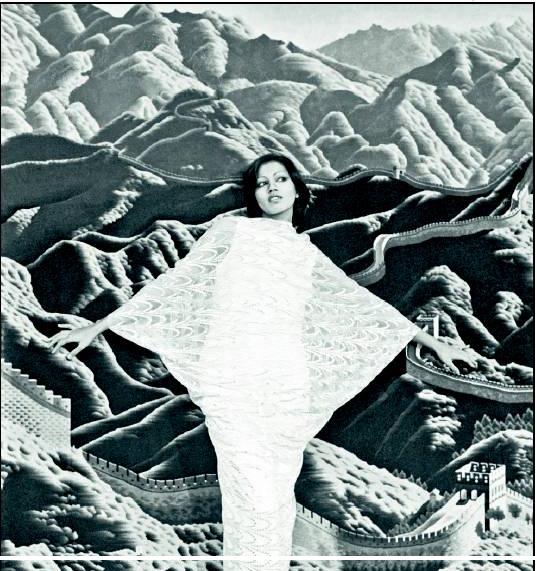Phyllis/ Anjali Mendes
Biography
Title and authorship of the original article(s)
|
Mendes, Phyllis/ Anjali Parisian saga of a babe from Byculla By Dileep Padgaonkar, Add source, Add date in format(MMM DD,YYYY) |
This is a newspaper article selected for the excellence of its content. |
Sometime in early June 1971, a woman called at my home in Paris, where I was posted as this newspaper’s correspondent, introduced herself as Phyllis Mendes, a model from Bombay, and said she had some news which could be of interest to me. She had arrived in the city two days earlier to seek an opening in the Mecca of haute couture. Within twenty-four hours, Pierre Cardin had engaged her, the first ever ‘coloured’ model in the history of France’s fashion business. She was eager to tell me her story down to the last telling detail.
My wife and I asked her over for dinner that very evening. Since she towered over both of us, the first thing I asked her was: ‘How’s the weather up there?’ Without a moment’s hesitation she answered: ‘Very, very cool. And down there?’ The repartee was the beginning of a friendship that remained intact, despite frequent interruptions lasting several years, for over four decades.
Throughout the evening, Phyllis spoke about the turns and twists in her young life: a strict, religious upbringing in a lower middle class Goan Roman Catholic family; a difficult childhood and adolescence in the back lanes of Byculla; indifferent studies in school and college; the initial forays in modelling; the first crushes and so forth. But what caught our attention was her fierce ambition to wow the rich and famous who frequented the salons of Parisian fashion designers. It reflected her deep-seated desire to get even with those who had heaped insults and indignities on her back home because of her class origins, dark skin, ordinary looks, poor eye-sight and, not least, her tall and lanky frame.
The day after the dinner Phyllis reported for work at Cardin’s plush offices on the elegant rue du Faubourg St Honore. That afternoon she called me to say that her bosses were unhappy with her first name since it did not sound Indian enough. Would I suggest one? I suggested ‘Geetanjali’ — Tagore’s work was known in France thanks to a fine translation by Andre Gide — but Phyllis thought it was too long. Besides, the French might not be able to pronounce it correctly. So I shortened ‘Geetanjali’ to ‘Anjali’ and told her that the worst they could do was to call her ‘en jolie’ and ‘jolie’, in French, meant ‘lovely’. From then on the world knew her as Anjali Mendes though for me, as for those who had known her in Bombay, she would always be Phyllis.
Our meetings became less and less frequent as we both went our separate ways. I returned to India while Phyllis travelled the world, first as a Cardin model, later as a business executive in charge of opening Cardin outlets in India and Pakistan. The meetings, whenever they did take place, turned out to be both delightful and disconcerting. I admired her drive and energy and took pride in her success and fame in the face of the heaviest odds.
At the same time, every encounter proved to be quite an embarrassment for she would run down people accusing them of some misdemeanour or the other. Soand-so was a shameless name-dropper, she would say, and promptly proceed to drop names of aristocrats and statesmen, businessmen and show business celebrities who had been flattering or courting her.
She would have a dig at a model, a business associate or a former friend for their indifference to intellectual and cultural pursuits. Yet her own reading was confined to glossy magazines specialising in high society gossip and Barbara Cartland romances. Her favourite expletive for women she hated was ‘whore’ but she thought nothing of flaunting her ‘conquests’: men who referred to her as an Indian princess, an Egyptian queen, a bird of paradise, an exotic fruit and, not least, as India’s ‘real’ ambassador to France. (One enraged Ambassador struck her off the Embassy’s guest list.)
In her eyes, those who were out to ‘get her’ — professional rivals, former friends, ex-lovers — had no class, character, good breeding or morals. She, on the other hand, attended mass on Sunday and read the Book of Psalms every day in order to remain on the straight and narrow path of Christian virtue.
Two months ago, on a visit to Delhi, she gave me the manuscript of her autobiography and asked me to edit it and help her find a publisher. It ran into 382 pages, each one more whacky than the other. It was, on the one hand, a fusillade of rants against all and sundry and, on the other, self-serving accounts of the highs and lows in her life.
But lurking beneath it all was another Phyllis: vulnerable to the feeblest slight, real or imagined, insecure to the extreme, aware at all times that life had denied her the one thing that she truly yearned for beyond fame and money: love that resembled a Barbara Cartland romance.
Phyllis died alone and abandoned in her home in the south of France last week. She had just moved in there from Paris. She was 64 years old. One should hope that the weather up there continues to keep her cool.
